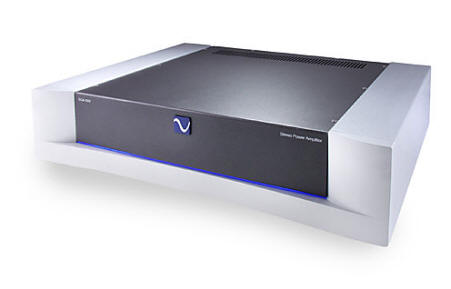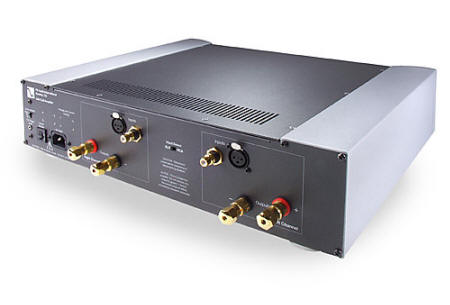You are reading the older HTML site
Positive Feedback
ISSUE
24
ps audio
GCA 100 amplifier
as reviewed by John Zurek

|
JOHN ZUREK'S SYSTEM
LOUDSPEAKERS
ELECTRONICS
SOURCES
CABLES
ACCESSORIES
|
Long, long ago, the first review I wrote for Positive Feedback Online (and transmitted over a dial-up connection) was on the HCA-2, PS Audio's entry into the world of Class D amplifiers. The HCA-2 made my Thiel 3.6s sound heavenly, and I've been a big fan of Class D amps ever since. I went out on a limb and predicted that they would have quite a future. I was glad that many high-enders agreed with me, though some did not—something about less-than-great measurements. Though not an expert, I have spent some time measuring components on the bench. While measurements give a general picture of a component's sound, in my experience they never nail it, so I'm not inclined to twitch an eyebrow when a great-sounding component doesn't measure well.
In the years since the HCA-2 was introduced, Class D amplifiers have endured, more and more of them (including the excellent Channel Islands amps) are making their mark, and the technology has been embraced by such megabuck manufacturers as Jeff Rowland. I still own the HCA-2, and use it as my reference amp. It has garnered many awards and accolades, but has had its share of controversy. Some say that it does not render high frequency detail properly, others have problems with the midbass. I think the naysayers may have been using speakers that did not match the amp well. I've used the HCA-2 with many speakers, among them the Thiel 3.6s, the Hyperion HPS-938s, and the Von Schwieckert Vr4 jrs, and have never heard any lack of detail or midbass.
A few weeks ago, I decided to stress-test the HCA-2. My audiobuddy Scott's megabuck solid-state amp had just gone belly up, and he decided to send it back to the manufacturer for surgery and upgrades. This would take about a month, so I suggested that he borrow the HCA-2. Because he is hopelessly addicted to non-stop music, he accepted. I was being a good audiophile, but I also had an ulterior motive—I wanted to hear the HCA-2 with his new speakers, the Green Mountain Audio Continuum 3s, in my opinion one of the finest speakers in the world. If the HCA-2 had flaws, these speakers would surely highlight them. The verdict? A striking combination. I schemed to wait until Scott went on holiday so I could sneak in and steal his loudspeakers. I'd just put a sheet over them when he came over—he'd never know the difference. His take? He called about three days later and said, "If I had to sum up this amp in one word, I'd say ‘articulate.' I'm loving it." High praise from Mr. Fussy Pants.
Why so much about the HCA-2? It is the perfect first-generation Class D amplifier to use in comparison with PS Audio's second-generation Class D amp, the GCA-100 ($2295). The GCA 100 is a stereo power amplifier that produces 100 watts per channel into 8 ohms, 200 watts per channel into 4 ohms, and drives speaker loads as low as 1.5 ohms. It has a damping factor that exceeds 1000, and is capable of driving most loudspeakers to live orchestral crescendo levels.

PFO has gotten some mail from readers regarding the use of B&O's ICE technology by PS Audio and other manufacturers. I'm not going to give you a technical explanation of the ICE Cell (truthfully, I couldn't find one), but I will tell you what Paul McGowan (the "P" in PS Audio) has to say:
We use a modified version of the ICE ASP modules, fed by our Gain Cell. So the combination of the Gain Cell (which is mostly responsible for the way it sounds) and the ICE Modules make up this line of products. We're not married to ICE, but for the moment they are the best thing going. The only thing we're married to is the Gain Cell.

The Gain Cell is PS Audio's proprietary second-generation technology for Class D. From the PS Audio website (www.psaudio.com):
Not just a gain stage, the Gain Cell represents an entirely new way of thinking about audio amplification. Gain Cells are not based on the traditional gain block that uses varying amounts of feedback to control the gain as is typical in solid state and tube designs. In fact, the Gain Cells are entirely different in their concept and operation and perform almost entirely in the current mode rather than the voltage mode. The PS Audio Gain Cell is a single block of analog gain in a potted module. You can place any size signal into the Gain Cell's input, from any source (balanced or not), and the Gain Cell will handle that input with near perfection. In fact, you can place up to 10 volts rms into the Gain Cell with no problem whatsoever. For reference, a typical CD or DVD player outputs perhaps 2 volts rms, some Audiophile DAC's can produce a whopping 5 volts rms, but the Gain Cell won't care.
I pulled the GCA 100 out of the box (with its excellent packing protection) and set it up in a matter of minutes. Looks? Ultra-modern, but sort of ho hum during the day. At night, the 100 takes on a very sexy glow courtesy of the blue, under-lit panel that runs almost all the way across the faceplate. You can adjust the brightness—sweet. The back of the amp features balanced and unbalanced inputs, heavy duty binding posts that I like much better than the HCA's, an IEC power connection, circuit breaker switch, 12-volt DC trigger, front lamp intensity switch, and an RCA/XLR input selector.
Before starting to listen, I placed the GCA 100 on a large slab of Rocky Mountain granite and put some vibrapods between the amp and the stone. The first thing I noticed was that the GCA was not as noisy as the HCA-2 at idle. Remembering that the HCA-2 took FOREVER to break in, I was prepared to wait. I put my CD player on repeat and let it cook. When I checked in at about 100 hours, it still sounded constrained at higher volumes. Back on repeat. Another 100 hours, nope. ANOTHER 100 hours, hmm, big difference. Dynamics were happening, and the amp was sounding pretty, pretty good, as Larry David would say. Now the fun started.
How do the GCA's 100 watts of new stack up to the HCA's 150 watts of not-so-new? When the 100 finally broke in, this is what I heard—a more articulate, sophisticated sound, improved dynamics, both micro and macro, improved delicacy, more weight and punch, more controlled bass, and cleaner, smoother highs. Each instrument and voice had more authority, was more palpable. The GCA 100 was oh-so-easy to listen to, and seduced me into listening much more that usual—a very good sign.
Listening to "Find Him" from Cassandra Wilson's New Moon Daughter was a pleasure. What really stood out was that when the volume increased, everything simply sounded bigger. The stage widened a little, and Wilson's voice went from a figurine to a huge statue. This is very similar to the way I have perceived increases in volume in live, unamplified performances. Jimmy Carl Black admirably handles the vocals on "Lonesome Cowboy Bert," from Frank Zappa's 200 Motels, lamenting his redneck loneliness. Zappa used some unusual recording techniques, to say the least, and "Bert" is a prime example. I was already chuckling before the ¾ B section began, and the GCA-100 presented nuances I'd never heard before in the almost Dylan-esque background chorus. Spatial cues were killer, resolution very good but not etched. By the time the track culminated in the famous "Where's my waitress?" line, I was laughing out loud. I really miss Frank. Imagine the material he could come up with about our country's current crop of "leadership."
I like to play "Temple Caves" from Mickey Hart's Planet Drum to hear how well an amp renders really low bass. Somewhere in the high 20Hz range, a large drum is struck—all acoustic, no synths involved. This is the one place that I felt the CGA was lacking. I could hear the low note of the Bata drum cleanly and clearly, but it did not energize the room as it does when I hook up the HCA-2.
The CGA 100 has a sophisticated, transparent, neutral sound. With its 100 lovely watts, it should be able to drive most speakers. I very much enjoyed my time with this amplifier. It made listening fun, the fatigue factor almost non-existent, the emotional factor very high. The CGA 100 is a bargain at its price, and is a most worthy successor to the HCA-2. Viva Class D! John Zurek
GCA 100 amplifier
Retail: $2295
PS Audio
web address: www.psaudio.com
